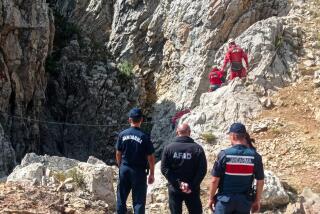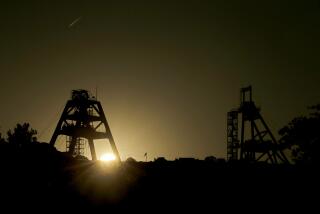Bright Future Seen for Maze of Caves
- Share via
KARTCHNER CAVERNS STATE PARK, Ariz. — Thirty years ago, two students from the University of Arizona stumbled onto a maze of caves that has since become the gem of the state’s parks system.
But by the time the upper portion of Kartchner Caverns opened to the public in 1999, the men who’d discovered them, Gary Tenen and Randy Tufts, were worried about the caverns’ survival. Sections were drying out, and moisture is essential to the growth of stalactites and stalagmites -- the cone-like formations that emanate from cave ceilings and floors.
“We saw things in the cave that really disturbed us,” said Tenen, 52. “Things drying out ... drier than we had ever seen it.”
Tenen and Tufts lobbied for the state to appoint a cave expert to monitor and analyze cave conditions. In April 2001, a cave resources manager, Rik Toomey, was named.
On Nov. 11, the lower portion of Kartchner was formally opened to the public. Tufts did not live to see it; he died of a rare blood disorder in 2002. But Tenen still watches the caves, and he says he’s pleased with Toomey’s work and the stewardship that the state now provides. Both Tenen and Toomey are optimistic about the caves’ future.
“We know there’s changes [inside the caves], and we’re trying to understand why,” Tenen said. “It’s much better than [where] we were in 1999 and 2000.”
“Overall, the environmental health of the cave is very good for a show cave,” Toomey wrote in a memo to state parks officials.
“Rik is our cave worrier,” parks Director Ken Travous said.
A world-class geologic wonder, Kartchner Caverns were carved half a million years ago by water cutting through Escabrosa limestone beneath the Whetstone Mountains. Today, the 2 1/2-mile maze is a $35-million tourist showcase with lights, airlocks to help preserve the internal atmosphere and concrete paths. More than 700,000 people have visited since it opened in 1999. Experts say Kartchner’s appeal rivals the beauty of New Mexico’s much larger Carlsbad Caverns.
Toomey says that other, undeveloped caves in southern Arizona are experiencing some of the same drying problems found in Kartchner, while shallow local groundwater wells show falling levels. Toomey believes that this suggests that ongoing drought conditions and regional climate changes might be responsible for the drier caves, rather than the impact of humans.
Studies are under way to determine how much of the change might also be attributable to Kartchner’s development for tours, including its trails, lighting and misting systems.
Meanwhile, the caves have experienced temperature increases ranging from 1 to 3.5 degrees, while humidity has dropped in some areas. A misting system sprays pumped water into portions of both the upper and lower cave complexes, but Toomey would like to phase out that practice. In his memo, he said he hopes to “work to guarantee the changes we have made minimally interfere with the natural functioning of the cave.”
Toomey believes that the impact of tourist amenities is lower than in some other caves. This is one subject where the cave czar and cave discoverer disagree; Tenen believes that the data show the impact of building trails and installing lights is actually greater than from the drought.
But, overall, Tenen is satisfied with Toomey’s work. He says he used to worry that the caves might not survive. “Now, I don’t,” he said. “It will.”
More to Read
Sign up for The Wild
We’ll help you find the best places to hike, bike and run, as well as the perfect silent spots for meditation and yoga.
You may occasionally receive promotional content from the Los Angeles Times.






